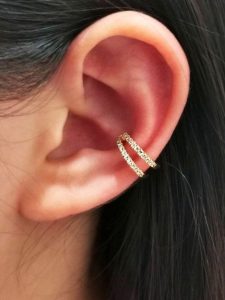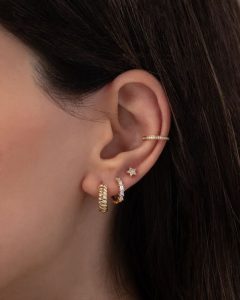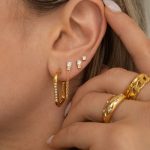Conch piercing is a trendy type of ear adornment that offer a unique and stylish look. There are two main variations: inner vs outer conch piercing. Both have their own distinct placement and appearance. This article will explore the inner conch piercing and the outer conch piercing to help you decide which might be right for you.
Conch piercings can be a great way to express yourself, but it’s important to choose the right type for your taste and anatomy.
Inner Conch Piercing
The inner conch piercing goes through the inner ridge of the conch, the shell-shaped cavity of your ear. It sits lower than the outer conch piercing and has a more subtle look.
Here are some things to consider about inner conch piercings:
Placement:
The inner conch piercing is placed on the softer inner cartilage of the ear. This area can be more sensitive than the outer cartilage.
Jewelry:
Labret studs are the most common type of jewelry for inner conch piercings. They offer a comfortable and discreet look.
Healing:
Inner conch piercings typically take 2 to 4 months to heal completely. Proper aftercare is crucial during this time.
Outer Conch Piercing
The outer conch piercing goes through the upper, flatter portion of the conch cartilage. It sits closer to the rim of your ear and has a more prominent look.
Here are some things to consider about outer conch piercings:
- Placement: The outer conch piercing is located on the firmer outer cartilage of the ear. This area is generally less sensitive than the inner cartilage.
- Jewelry: A wider variety of jewelry can be worn with outer conch piercings, including hoops, labrets, and barbells. This allows for more customization.
- Healing: Outer conch piercings typically heal in 3 to 6 months. As with inner conch piercings, proper aftercare is essential.
Choosing Between Inner and Outer Conch
Ultimately, the choice between an inner conch piercing and an outer conch piercing depends on your personal preferences. Here are some factors to consider:
- Desired look: Do you prefer a more subtle or a more prominent look for your piercing?
- Pain tolerance: The inner conch may be slightly more sensitive during piercing and healing due to its location.
- Jewelry style: Consider the type of jewelry you’d like to wear. Outer conch piercings offer more versatility.
- Anatomy: Not everyone’s anatomy is suitable for both placements. Consult a professional piercer to see which option works best for your ear.
No matter which type of conch piercing you choose, it’s important to find a reputable piercer who uses sterile equipment and follows safe piercing practices.
Safety and Aftercare
Regardless of whether you choose an inner conch or outer conch piercing, safety and aftercare are crucial. Here are some important things to remember:
- Reputable piercer: Always go to a professional piercer who uses sterile equipment and follows safe piercing practices.
- Aftercare instructions: Follow the aftercare instructions provided by your piercer carefully. This will typically involve cleaning the piercing with a saline solution and avoiding irritation.
- Healing time: Be patient during the healing process, which can take several months.
- Risks and complications: Be aware of the potential risks and complications associated with conch piercings, such as infection, allergic reaction, and bleeding.
If you experience any unusual swelling, redness, or persistent pain, consult a doctor or piercer immediately.
Conch piercings, both inner and outer, can be a stylish and unique addition to your body art. By understanding the placement, jewelry options, and aftercare requirements for each type, you can make an informed decision about which one is right for you. Remember, prioritize safety and consult with a professional piercer before getting any piercing.
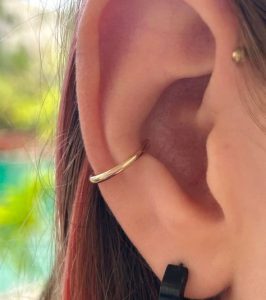
Inner vs. Outer Conch Piercing: Considerations
Conch piercings are a popular body modification, and understanding the two main variations – inner and outer conch – is important. Here’s a breakdown to help you decide which might suit you better:
Look and Feel
-
Inner Conch: Offers a subtle and discreet look. The placement on softer cartilage might feel more sensitive during piercing and healing.
-
Outer Conch: Has a more prominent look due to its position near the rim of the ear. The placement on firmer cartilage is generally less sensitive.
Jewelry Options
-
Inner Conch: Typically accommodates labret studs for a classic look.
-
Outer Conch: Offers more versatility with hoops, labrets, and barbells, allowing for customization.
Healing Time
-
Inner Conch: Generally heals in 2 to 4 months.
-
Outer Conch: Typically heals in 3 to 6 months.
Remember, healing times are estimates and can vary depending on individual factors.
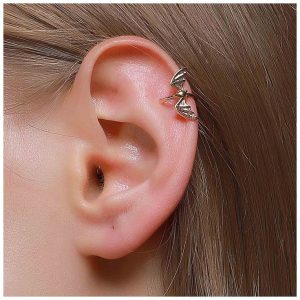
Consulting a Professional
Ultimately, the best way to decide between an inner and outer conch piercing is to consult a professional piercer. They can assess your anatomy, discuss jewelry options, and address any concerns you may have.
Here are some questions to consider asking your piercer:
- Which type of conch piercing would best suit my ear anatomy?
- What kind of jewelry would be appropriate for a new conch piercing?
- What aftercare instructions should I follow for a conch piercing?
- What are the potential risks and healing times associated with conch piercings?
By getting information from a professional, you can make an informed decision about this body modification.
Inner vs. Outer Conch Piercing: Aesthetics and Self-Expression
Conch piercings offer a unique canvas for self-expression through jewelry and placement. Here’s a deeper look at how each type can influence your look:
Inner Conch: Subtle Sophistication
- Discreet placement: The inner conch sits lower and can be partially hidden by hair, creating a subtle and sophisticated look.
- Jewelry options: Labret studs come in various materials, colors, and gem embellishments, allowing for a personalized touch within a classic style.
Outer Conch: Bold and Expressive
- Prominent placement: The outer conch is closer to the rim of the ear, making it a more noticeable and eye-catching adornment.
- Jewelry versatility: Outer conch piercings accommodate a wider range of jewelry like hoops, barbells, and curved barbells. This allows for bolder statements and geometric designs.
Ultimately, the best choice comes down to your personal preference. Consider what kind of vibe you want to project with your piercing. Do you prefer something understated or a more striking statement piece?


